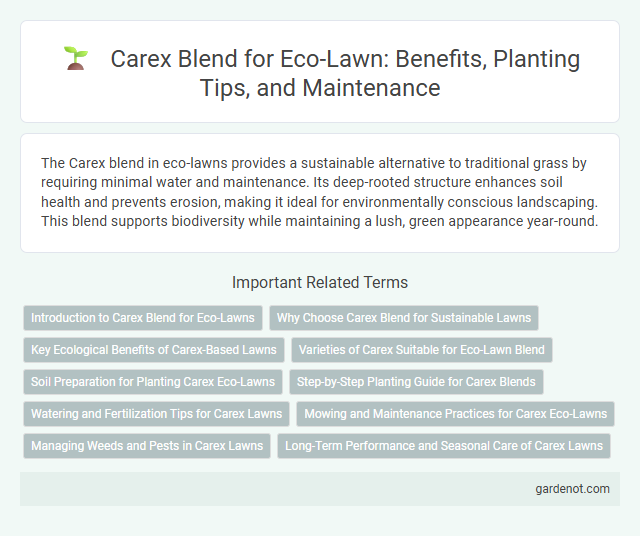The Carex blend in eco-lawns provides a sustainable alternative to traditional grass by requiring minimal water and maintenance. Its deep-rooted structure enhances soil health and prevents erosion, making it ideal for environmentally conscious landscaping. This blend supports biodiversity while maintaining a lush, green appearance year-round.
Introduction to Carex Blend for Eco-Lawns
Carex blend offers an ideal solution for eco-lawns with its drought-tolerant, low-maintenance sedge varieties that thrive in various soil conditions. This mix promotes biodiversity and soil health by providing habitat for beneficial insects and reducing the need for fertilizers and irrigation. Carex blend's dense growth habit effectively suppresses weeds while enhancing the aesthetic appeal of sustainable, eco-friendly lawn spaces.
Why Choose Carex Blend for Sustainable Lawns
Carex blend is ideal for sustainable lawns due to its deep root system, which enhances drought tolerance and reduces water consumption by up to 40%. This grass alternative supports soil health by improving aeration and minimizing erosion, while requiring significantly less fertilizer and pesticides. Choosing Carex blend promotes biodiversity and creates a resilient, low-maintenance lawn that thrives in diverse environmental conditions.
Key Ecological Benefits of Carex-Based Lawns
Carex-based lawns provide essential ecological benefits such as enhanced biodiversity by supporting pollinators and soil microorganisms. Their deep root systems improve soil structure and water retention, reducing erosion and the need for irrigation. These low-maintenance plants also absorb higher levels of carbon dioxide, contributing to climate change mitigation through natural carbon sequestration.
Varieties of Carex Suitable for Eco-Lawn Blend
Carex varieties such as Carex flacca, Carex pansa, and Carex elata are ideal for eco-lawn blends, offering drought tolerance and low maintenance requirements. These species provide dense, fine-textured foliage that enhances soil stabilization and biodiversity. Incorporating these Carex types supports sustainable landscaping by reducing the need for irrigation and chemical inputs.
Soil Preparation for Planting Carex Eco-Lawns
Soil preparation for planting Carex blend eco-lawns requires thorough loosening and removal of debris to ensure optimal root establishment. Amending soil with organic matter enhances moisture retention and nutrient availability, crucial for the diverse Carex species adapted to eco-lawns. Proper grading and drainage must be maintained to prevent waterlogging, promoting healthy growth and longevity of the Carex eco-lawn.
Step-by-Step Planting Guide for Carex Blends
Select a well-drained, partially shaded area for the Carex blend, ensuring soil pH ranges between 5.5 and 7.0 to optimize growth. Prepare the soil by loosening it to a depth of 6 inches and incorporate organic compost to enhance moisture retention and nutrient availability. Plant Carex plugs or seeds spaced 12 to 18 inches apart, water thoroughly after planting, and maintain consistent moisture until established.
Watering and Fertilization Tips for Carex Lawns
Carex blend lawns require consistent moisture, especially during establishment, with watering schedules adjusted to prevent both drought stress and waterlogging, ideally providing about 1 inch of water per week. Fertilization should be minimal yet balanced, using slow-release, low-nitrogen fertilizers to promote healthy, dense growth while avoiding excessive nutrient runoff. Monitoring soil moisture and nutrient levels ensures optimal care, supporting drought resistance and robust green coverage in Eco-lawn Carex mixes.
Mowing and Maintenance Practices for Carex Eco-Lawns
Carex blend eco-lawns require mowing at a higher height of approximately 3 to 4 inches to promote healthy growth and maintain soil moisture. Regular maintenance involves infrequent mowing, typically every 2 to 3 weeks during the growing season, reducing stress on the plants and limiting weed invasion. Minimal fertilization and irrigation needs make Carex blends a sustainable option for environmentally conscious lawn care.
Managing Weeds and Pests in Carex Lawns
Carex blend lawns exhibit natural resistance to common weeds and pests, reducing the need for chemical treatments and promoting sustainable landscaping. The dense root structure of Carex creates a thick turf that outcompetes invasive species, minimizing weed intrusion while discouraging pest habitats. Consistent maintenance such as proper mowing height and adequate irrigation further enhances the lawn's resilience against infestations and undesirable plant growth.
Long-Term Performance and Seasonal Care of Carex Lawns
Carex blend lawns offer exceptional long-term performance due to their deep root systems and drought tolerance, ensuring resilience through varying weather conditions. Seasonal care includes minimal mowing in spring and fall, along with light watering during dry periods to maintain optimal growth and prevent stress. Proper maintenance enhances the natural disease resistance of Carex species, promoting sustainable and eco-friendly lawn health year-round.
Carex blend Infographic

 gardenot.com
gardenot.com